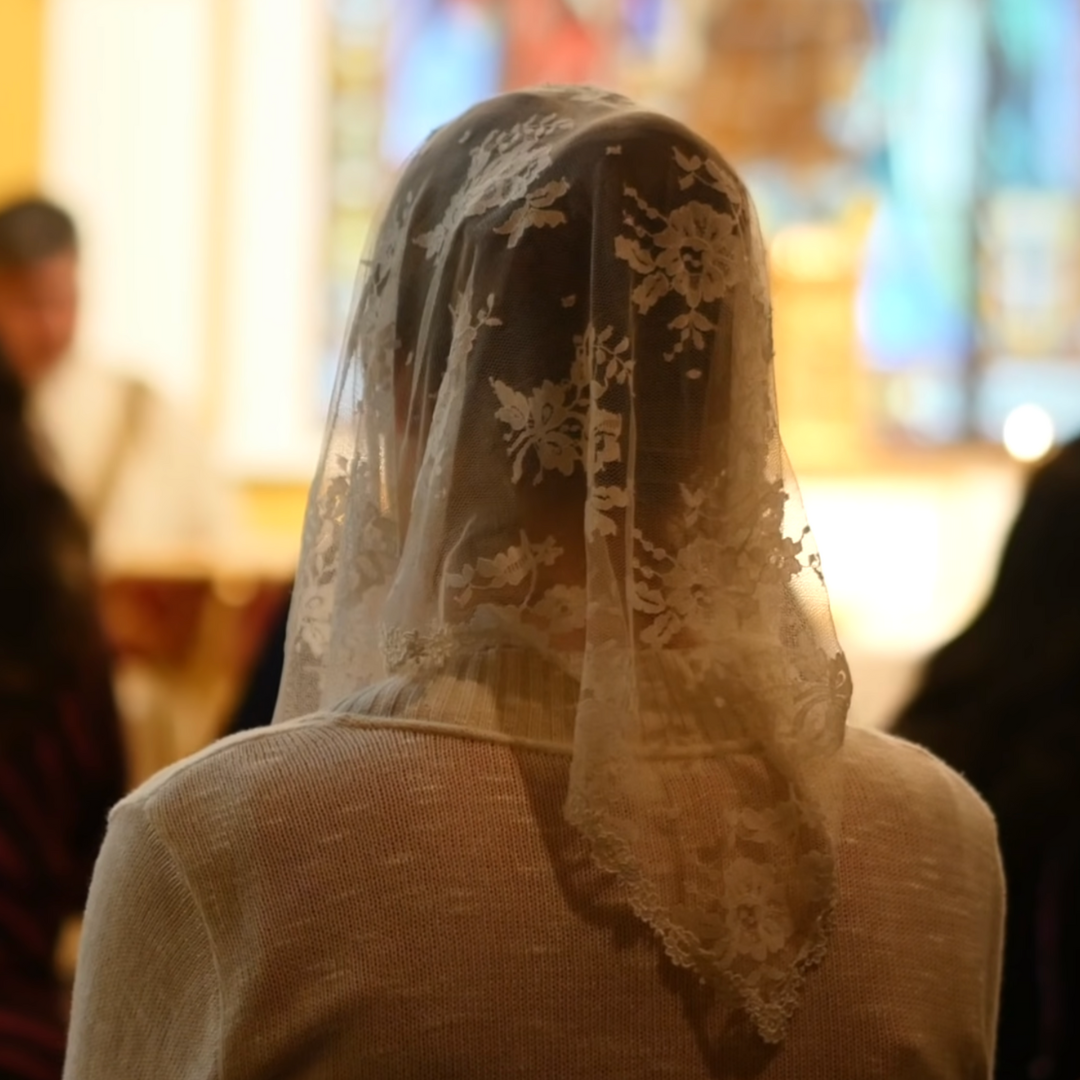Not that long ago, Christian women always covered their heads at church, and now many are choosing to do so once again.
While lots of women are going the route of the chapel veil, others are choosing things like hats, scarves, or stylish headbands.
What are their reasons for doing this?
1) Veiling is in the New Testament.
"Be imitators of me, as I am of Christ. I praise you because you remember me in everything and hold fast to the traditions, just as I handed them on to you. But I want you to know that Christ is the head of every man, and a husband the head of his wife, and God the head of Christ.
"Any man who prays or prophesies with his head covered brings shame upon his head. But any woman who prays or prophesies with her head unveiled brings shame upon her head, for it is one and the same thing as if she had had her head shaved. For if a woman does not have her head veiled, she may as well have her hair cut off. But if it is shameful for a woman to have her hair cut off or her head shaved, then she should wear a veil.
"A man, on the other hand, should not cover his head, because he is the image and glory of God, but woman is the glory of man. For man did not come from woman, but woman from man; nor was man created for woman, but woman for man; for this reason a woman should have a sign of authority on her head, because of the angels. Woman is not independent of man or man of woman in the Lord. For just as woman came from man, so man is born of woman; but all things are from God.
"Judge for yourselves: is it proper for a woman to pray to God with her head unveiled? Does not nature itself teach you that if a man wears his hair long it is a disgrace to him, whereas if a woman has long hair it is her glory, because long hair has been given [her] for a covering? But if anyone is inclined to be argumentative, we do not have such a custom, nor do the churches of God."
Now, I know that this is a hotly debated passage, but let me try to explain.
2) The Church veils sacred things.
The tabernacle is veiled. The chalice is veiled. Altars are veiled. Moses veiled his face after he saw God. A veiled woman shows reverence for God, symbolizing the veiled bride of the Church, but also honors herself as a woman before God.
3) Men and women are different.
Men represent Christ, the bridegroom, which is why we have the male priesthood. Women represent the Church, the bride. All laymen take part in the feminine nature of the Church, but women symbolize the Church as the bride.
Veiling goes against a society that tells us that men and women are the same, that there are many genders, and that gender is not important when people want to marry.
Veiling is an outward statement against modernity and its lies.
A woman choosing to be submissive as a wife, as a woman, to her husband is against all that our society tells us about man and woman. Saint Paul talks about women submitting to their husbands, the Church submitting to Christ, Christ loving the Church to the point of His suffering and death, and husbands loving their wives in this same way.
4) Women and men are equal.
Saint Paul said this, which went against his culture’s ideas about men and women:
"Woman is not independent of man or man of woman in the Lord. For just as woman came from man, so man is born of woman; but all things are from God." (1 Cor. 11:11-12)
Christianity has made men and women equal in God, and Saint Paul says this right in the middle of the passage where he talks about women covering their heads.
It is important to remember that when Jesus and Saint Paul talk about women in the Scriptures, it is in a new and counter-cultural way.
Women veiling does not put them lower than men but must be seen in conjunction with men not covering their heads.
It emphasizes the difference between men and women, and the symbol they are as the image of God.
5) The veil accentuates the natural beauty of a woman.
Saint Thomas Aquinas explains in his commentary on the veiling passage of 1 Corinthians that human beings in general naturally augment their natural beauty with clothing.
Women naturally have beautiful hair, and a veil ornaments and accentuates that beauty. In general, we want to bring the best of ourselves to the liturgy, and veiling is a way of doing so.
6) Veiling is part of the tradition of the Apostles.
Saint Paul writes that he wishes the Corinthians to “hold fast to the traditions, just as I handed them on to you.”
He did not make this up just for their culture. Rather, he passed on a tradition of women covering their heads and men not doing so. This tradition was from the Apostles and it was maintained until the 1960s.
The 1917 Code of Canon law required women to cover their heads and forbade men from covering their heads. The 1983 Code of Canon Law omitted the passage about women covering their heads but maintained that men should not.
It is unclear why Canon Law changed, though it is clear that head covering by women is no longer required by Church law.
It is also clear that this is a tradition that was passed down, and as laity, there is no reason why we cannot continue that tradition even if it is not in the Code of Canon Law.
7) Some women pray better while veiling.
Some are choosing to veil not just in church, but anytime they pray in private or in public. It is a way to help them focus. A prayer to pray when putting on a veil when entering a Church is, “Blessed am I whom am called to the marriage feast of the Lamb.”
8) Veiling or wearing a hat immediately dresses one up for church.
Whether at church on a weekday or on a Sunday, when a woman puts something on her head, she says to herself and others that she is dressed for church.
A working woman can mentally distinguish between work attire and church attire by wearing a veil. A woman who wears “mommy clothes” all day can instantly be dressed up for church when she puts on a veil.
9) Robing oneself in a beautiful veil in the presence of God feels right.
It makes the woman feel beautiful, and some husbands find them attractive. The beauty of the veil is something that honors God in the same way beautiful architecture or beautiful vestments do. They contribute to giving God the worship that is due to Him.
10) Because of the Angels.
Saint Thomas Aquinas explains this statement from 1 Cor. 11:10 simply stating that it is because Angels are present at the Holy Sacrifice of the Mass, that men must show reverence as well as women.
Women show reverence by covering their heads, and men show reverence by not covering their heads.
Bonus Fact:
Women still cover their heads when they have an audience with the Pope.


